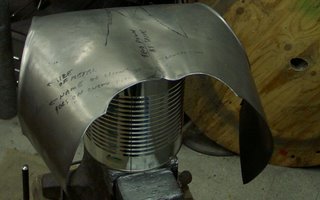

Piece of cake at this point! The armour now has to be curved around the horn of the anvil to help it to fit the body. The backplate normally fits under the breastplate, and the upper part of the backplate (the part we have been working on) will fit neatly over the bottom parts. I like the look of the three part armours, though of course, backplates were made as single and two piece plates as well.
Wipe the pieces down with lacquer thinner to take off markings from your sharpie pen, and to take off fingerprints. A quick coat of high gloss spray lacquer at this point will dry in 5 minutes, and will protect the finish against fingerprints. I often give it a good sanding with a succession of grits from 8o on up to 120 grit with a palm sander, but a lot of people prefer the look of the planished steel. So do I actually, so I often don't try very hard to get all the hammer marks out. People who complaing about hammer marks on armour would complain about brush strokes on a painting! A lot of people decide to like the hammer marks when they discover they have to pay me 20 bucks an hour to sand them all out.
As you can see in the picture, the hammer marks are not really all that intrusive. You have to watch people who skip the planishing stage and then brag about how "handmade" their armour looks. Thats just bad workmanship. Your armour should be smooth enough after planishing that you would take no more than one gauge number off when sanding all the marks out. Real medievel armour was heavily sanded! They often took off two or even three gauge sizes off the steel in the process of sanding it. I'm not sure why this is....but I have a suspicion that sanding is a job which can be done by a slave, or an apprentice, whereas planishing would need the expensive services of a trained craftsman. That is not the only answer of course...perhaps they had water powered wheels which did the job really fast...so it would take less time to sand it than to planish it smooth. Hard to say, both speculations can be supported in literature.
No comments:
Post a Comment